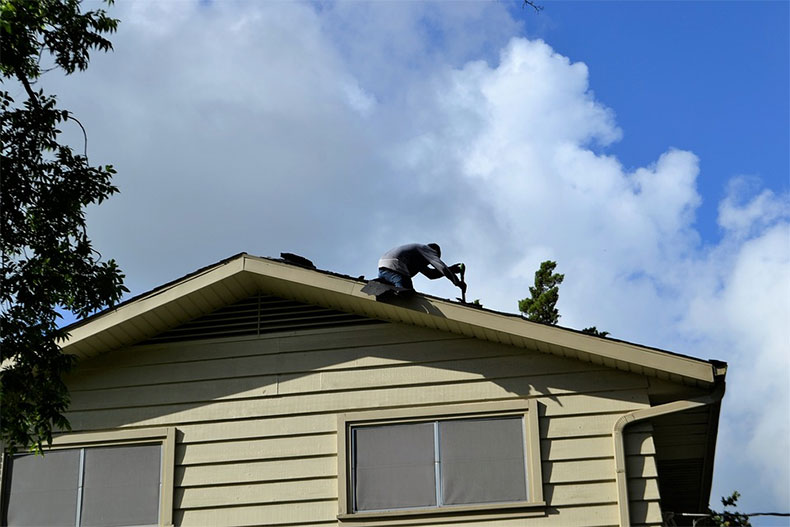Although often overlooked, your roof requires regular upkeep and maintenance as much as any of the other parts of your house. Actually, maintaining your roof is probably one of the most important things you can do for the value and security of your home since it’s your first line of defense against rain, snow, and the elements. Regular inspections and occasionally repair work are a must, but as you might expect, roof work can be risky and even dangerous. Being diligent about safety is absolutely critical during any housing project, and this is especially true when you’re working high up on the roof. Here are five things you can do to ensure your safety while roofing.

Table of Contents
Know the Risks
Before you even think about starting a project, you should take care to be aware of the risks involved in climbing around on a rooftop. Some of these risks are common to every roof, while others may be specific to your home. Be aware of things such as the location of ladders, if any are present; any chemical hazards; any obstacles you cannot easily climb or walk around; any electrical cables; debris that has built up; and the slope of the roof. It’s also important to know how thick and sturdy the roof is. In areas where it’s thinner, such as near skylights, it may be dangerous to walk.
Hazards will vary depending on the time of year as well: for example, working on a roof becomes a lot more dangerous if it’s wet and rainy or icy. Extreme heat is another thing you should avoid if you want to be safe roofing. Not only can working on a very hot day pose a threat to you, it can also compromise the work you’re doing. Shingles are easily damaged, such as with scuffs and mars, when working in hot weather.
Get the Right Equipment
No roof work should be attempted without having the right safety equipment on hand. Since some of this equipment is very specialized, you should make sure you have access to what you need before you begin.
As you might expect, the first thing on your list should be a ladder. It’s not enough to simply have a tall ladder you can lean against your roof. You must be on the lookout for hazards, such as overhead lines or uneven ground, and tie the ladder to the roof for added stability. Similar to ladders, you may need to make use of toe boards, which are designed to give you a foothold to put your feet on when climbing a steep roof. Safety harnesses are also critical; make sure you have one that can anchor to the roof and arrest any falls.
Develop a Plan
Once you’ve familiarized yourself with the quirks and hazards of your particular roof and acquired the right safety equipment for the job, it’s time to start creating a plan. Know where you’ll place your ladders, how you’ll climb on and off the roof, and where you can stand safely. Decide where you’ll attach your toe boards and where you can safely place the anchors for your safety harness.
Besides safety equipment, make sure you have all the right tools that you need all in one spot. You’ll reduce the risks if you don’t have to run from place to place looking for the items you need. Figure out where you’ll be working and what type of work you’ll be performing. It’ll be easier to be safe roofing if you’re as efficient as possible with the job itself.
As part of your plan, make sure you have a friend who can assist with the job. When it comes to roofing safety, it’s important to have an extra set of eyes, as well as an extra set of hands. Your helper may notice safety hazards you miss, and with two people working on the job, you’ll have someone who can contact emergency services if the worst happens and there is an accident.
Use Common Sense
It’s no coincidence that more than half of the entries on this list deal with the prep work before you even begin the job. There’s just no substitute for being prepared. It’s critical when you are doing any housework where safety is an important factor. With that said, however, no level of preparation will help you if you aren’t vigilant about safety when performing the job itself.
First and foremost: don’t rush. Take your time with the work and talk through everything you’re doing with your partner. Exercise care and caution when moving from place to place as well. Move slowly and with purpose, always walk, and never jump from one area to another on your roof. Make absolutely sure all of your safety equipment is in place before you do anything.
You’ll want to exercise safety when using the tools of the job as well. Follow all the instructions for using any power tools, for example. Always make sure that a nail gun is placed directly against a shingle before you pull the trigger. Wear gloves and safety glasses Don’t touch anything that might be unsafe, such as hot tar or exposed nails.
Don’t Be Afraid to Hire Pros
In the world of roofing, accidents often happen when people try to get in over their heads. Another extremely important element of roofing safety is to know your limitations. If you don’t feel comfortable with an element of a job, you don’t have to do it. Attempting to do a job yourself may save you a few dollars, but that won’t matter if you’re injured attempting to carry out a task. Do not be shy; if necessary, find a professional to do the job for you. A company like Interstate Roofing can perform maintenance and upkeep work—as well as emergency repairs—for a reasonable price. In many cases, this is the best way to be safe while roofing.











Leave a Reply